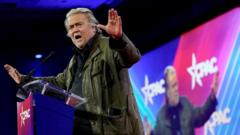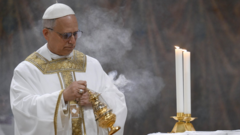As the Vatican gears up for its first conclave in 12 years, following the death of Pope Francis, the process remains cloaked in secrecy. Key preparations and strict rules will govern the election of the next pontiff.
Vatican Prepares for Historic Papal Conclave Following Francis' Death

Vatican Prepares for Historic Papal Conclave Following Francis' Death
The conclave to elect a new pope will commence soon at the Vatican, marking a significant moment in the Catholic Church's leadership transition.
The first papal conclave in over a decade is set to take place on Wednesday at the Vatican, following a morning Mass in St. Peter’s Basilica. At 4:30 p.m. local time (10:30 a.m. Eastern), cardinal electors will proceed in a solemn procession to the Sistine Chapel to commence their voting. The opening of the conclave will be signaled by the master of pontifical liturgical celebrations announcing "extra omnes," a phrase meaning “everyone out.” This announcement permits entry only to the 133 cardinal electors, those under 80 years of age eligible to cast votes in the conclave, while others are asked to leave the chapel.
Once the conclave commences, there are strict protocols: cardinals cannot leave the Vatican except for meals and overnight rest until a two-thirds majority vote for the next pope is achieved. To enhance the focus on the voting process, contact with the outside world through smartphones, internet, and television is prohibited and closely monitored, aiming to prevent delays.
Discussions regarding the direction of the Church started posthumously after Pope Francis passed away on April 21, with cardinals converging in the Vatican for both the necessary preparations for the funeral and to engage in early dialogues about pressing issues facing the Catholic Church.
Timing for the conclave is crucial; it traditionally begins within 15 to 20 days following a pope's death. This conclave is poised to kick off 16 days post-Francis' passing, a timeline that allows ample preparation time, according to Matteo Bruni, the Vatican spokesman.
Preparatory measures have included the closing of the Sistine Chapel to visitors, ensuring a focused atmosphere, and arranging for the stoves that will incinerate the ballots cast by the electors, a significant step in maintaining tradition and secrecy within this sacred process.
Once the conclave commences, there are strict protocols: cardinals cannot leave the Vatican except for meals and overnight rest until a two-thirds majority vote for the next pope is achieved. To enhance the focus on the voting process, contact with the outside world through smartphones, internet, and television is prohibited and closely monitored, aiming to prevent delays.
Discussions regarding the direction of the Church started posthumously after Pope Francis passed away on April 21, with cardinals converging in the Vatican for both the necessary preparations for the funeral and to engage in early dialogues about pressing issues facing the Catholic Church.
Timing for the conclave is crucial; it traditionally begins within 15 to 20 days following a pope's death. This conclave is poised to kick off 16 days post-Francis' passing, a timeline that allows ample preparation time, according to Matteo Bruni, the Vatican spokesman.
Preparatory measures have included the closing of the Sistine Chapel to visitors, ensuring a focused atmosphere, and arranging for the stoves that will incinerate the ballots cast by the electors, a significant step in maintaining tradition and secrecy within this sacred process.























